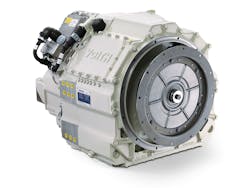The New S111 Turbo Transmission from Voith
Special rail vehicles must be able to handle special requirements, and reliability, availability and flexibility are top priorities. The new Voith S111 Turbo Transmission fulfills these characteristics using proven technology and is already demonstrating this with a two-axle tender vehicle in China.
These tender vehicles are equipped with a crane, flatbed or personnel cab-in and are used in applications such as track maintenance tasks on high-speed segments. Vehicle operators must be able to rely on these tender vehicles to start reliably, maintain availability, and avoid break downs. As a hydrodynamic transmission, the new Voith S111 Transmission ensures that these criteria are fulfilled.
One Converter, One Coupling – Compact Design
The Voith transmission is designed for maximum engine powers of 280 kW and 1800 Nm with one converter and one coupling. This is adequate for special vehicles in the lower power segment. Combined with the virtues of hydrodynamics, these robust, heavily driven machines offer a long service life and are easy to maintain. This is accomplished through the hydrodynamics technology, which protect the engine and drive components, and due to the fact that it decouples vibrations. Stepless starting and an automatic speed adjustment without interruption of tractive effort are other positive features that distinguish the hydrodynamic transmission and all Voith turbo transmissions.
The extremely compact design, based on the innovative superimposing gear on the front side and the indirect bearing concept, has been particularly successful. This concept has a positive impact especially during maintenance. This impact is due to the fact that new Voith S111 Turbo Transmission places all controls related to maintenance and service on the left side of the transmission, making them easier to see and to access.
